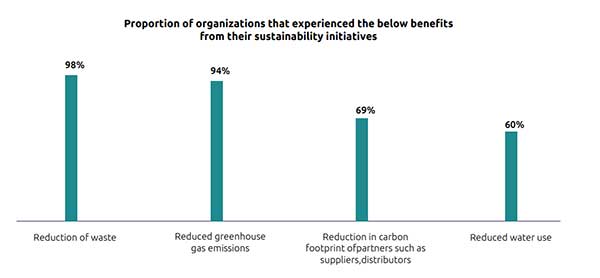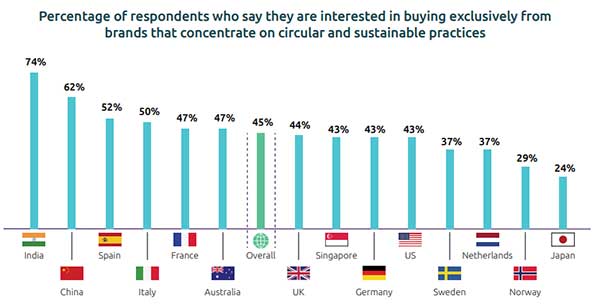How prioritizing the circular economy will pave the way for transformation.
By Nisar Ahamad, VP and Sector Head for Energy, Utilities, and Chemicals (EUC), Capgemini Engineering and Vamshi Rachakonda, Vice President, Manufacturing, Automotive and Life Sciences, Capgemini Americas
Sustainability has been a hot topic in recent years, and those paying attention know that it has become more than just a buzzword. Environmental activism and protection is here to stay, and organizations are getting on board across industries.
One sector that has typically fallen behind is manufacturing. In fact, 95% of manufacturing organizations say the push to reduce CO₂ emissions across all tiers of the supply chain will impact them, but only 13% are well equipped to accommodate this. However, leaders in this space have started to recognize the importance of integrating sustainability into their roadmaps to pave the way for a greener future.
Transforming from the ‘old way’ to the ‘green way’ will take collaboration, dedication, and empowered leadership – but holds the promise of untapped potential and significant business growth.
To best understand where we’re going, it makes sense to evaluate where we’ve been. Traditional manufacturing prioritizes cost-effectiveness and profit margins while often neglecting environmental impact. This old way of operating does not consider the circular economy or how to repurpose existing components – but consumers are beginning to demand more.
The next generation of manufacturing, which many are referring to as ‘green manufacturing’, prioritizes sustainability throughout all manufacturing processes, such as:
While this shift may seem like a no brainer, many manufacturers struggle with leaving behind the cost-effectiveness of traditional manufacturing. What many fail to realize is that sustainable manufacturing appears expensive in the short-term but has significant cost benefits in the long-term.

Establishing organizational enablers to support the seamless transition towards sustainable manufacturing can provide organizations with the confidence to succeed. Such enablers include:
What’s further, The Environmental Protection Agency (EPA) has worked hard to promote this shift, even providing customized assessments for small and medium-sized manufacturers. They have outlined the three E’s – energy, environment, and economy – to push enterprises to reduce energy usage, pollution, and water usage for the overall good of the environment, while still protecting their profit margins.
One key concept in product development is component obsolescence. This refers to an individual element of a product having a lifecycle that is independent of the product as a whole. This allows for individual components to be tested, modified, and/or replaced without affecting the overall product.
This is important because when individual components can be replaced independently, the cost of replacing an entire product can be reduced. Additionally, component obsolescence can aid in the development of new products.
This ties back to circular economy. The limitations on semiconductors for product development show the gap that could be filled by reusable materials – keeping circularity in mind. Most companies will discard their old products to a landfill and replace them with a new model that will be obsolete before its lifespan ends, and the cycle continues. However, if the manufacturers began developing products with reusable materials, this would ultimately decrease the cost of either replacing the entire product every few years or tracking down obsolete chips selling at a high price point.
For this reason, product replacement – with reusable materials – is often a better option than product repair when some parts of the product are no longer available. This is due to the fact that product replacement is more cost-effective, as it eliminates the need for expensive repairs and can help maintain the product’s lifespan. Additionally, product replacement helps promote sustainability because the newer products are designed and developed with sustainability in mind, which will reduce future e-waste.
Transforming this industry will have extensive significance, rippling throughout society. Manufacturing generates our entire product ecosystem – whether it’s automotive, aerospace, healthcare – nothing can come to market without being manufactured.
Aside from the environmental and greater societal impact, pushing sustainable manufacturing will soon be a mandated reality. The Securities and Exchange Commission (SEC) will begin measuring emissions against sustainability metrics, making environmentalism a priority for manufacturers from a reporting and measurement perspective. However, leaders should think of sustainability as an integral part of their business and as an opportunity to improve their operations for a better future, not as an unwelcome directive or box they need to check off. What’s further, by taking advantage of the technological innovations in material science, quality management, and beyond, organizations can fully realize the potential for business growth that they can achieve by being more sustainable.
Finally, sustainability will be a crucial aspect for brand-building. Research shows that today’s consumers engage more readily with brands and retailers that they perceive to be sustainable and genuinely committed to green practices. In fact, almost half (48%) of consumers say that they share an emotional connection with products or organizations that demonstrate these qualities. This is especially true of the majority of Generation Z shoppers, who are even willing to spend 10 percent more on sustainable products. This can open the door for capital investment from stakeholders who know the importance of brand reputation.

Organizations looking to define themselves as a sustainable brand will need to walk the walk, not just talk the talk. In order to earn the respect of consumers, reap the benefits of government incentives, and truly innovate to a more efficient and eco-friendlier brand, manufacturers will need to commit to being green. This requires doing research on the way products are manufactured, what materials are being used, how to integrate reusable components and improve operational efficiency – not just claiming to promote environmental protection.
Transitioning to the circular economy in the manufacturing industry provides opportunities and benefits for organizations by reducing the heavy reliance of finite resources and well as reducing the environmental impact. From a manufacturing industry perspective, the opportunity for sustainability to impact this sector is significant, with more and more organizations realizing the vast landscape of tools and technologies available that could help them on their journey.
Earth’s resources are limited, and consumers know it. Manufacturers who hold firm to traditional methods risk more than just our planet, they risk the respect of consumers and their brand reputation in the process.

Nisar Ahamad is the Americas Sustainability Lead for Energy, Utilities, and Chemicals (EUC) at Capgemini Engineering. He has over 23 years of experience building and leading EUC, sustainability, industrial and communication businesses. Nisar has expertise in multiple engineering functions and has supported teams in AMI (Advanced Metering Infrastructure), intelligent industry, communications (wireline, wireless 4GLTE/5G), AI/ML (Artificial Intelligence & Machine Learning) and product support services.

Vamshi Rachakonda is the Vice President of Manufacturing, Automotive and Life Sciences at Capgemini Americas. He has 20 years of experience building high growth teams across multiple organizational functions, and his blend of management consulting and IT expertise has helped organizations in sectors such as manufacturing, automotive, life sciences and beyond realize their business goals.
In this episode, I sat down with Beejan Giga, Director | Partner and Caleb Emerson, Senior Results Manager at Carpedia International. We discussed the insights behind their recent Industry Today article, “Thinking Three Moves Ahead” and together we explored how manufacturers can plan more strategically, align with their suppliers, and build the operational discipline needed to support intentional, sustainable growth. It was a conversation packed with practical perspectives on navigating a fast-changing industry landscape.